Alistair Coburn: Team Development and Agile
Today is the birthday of one of the founding fathers of the Agile Manifesto , Alistair Cobern . I bring to your attention the translation of his speech on TED about team development.
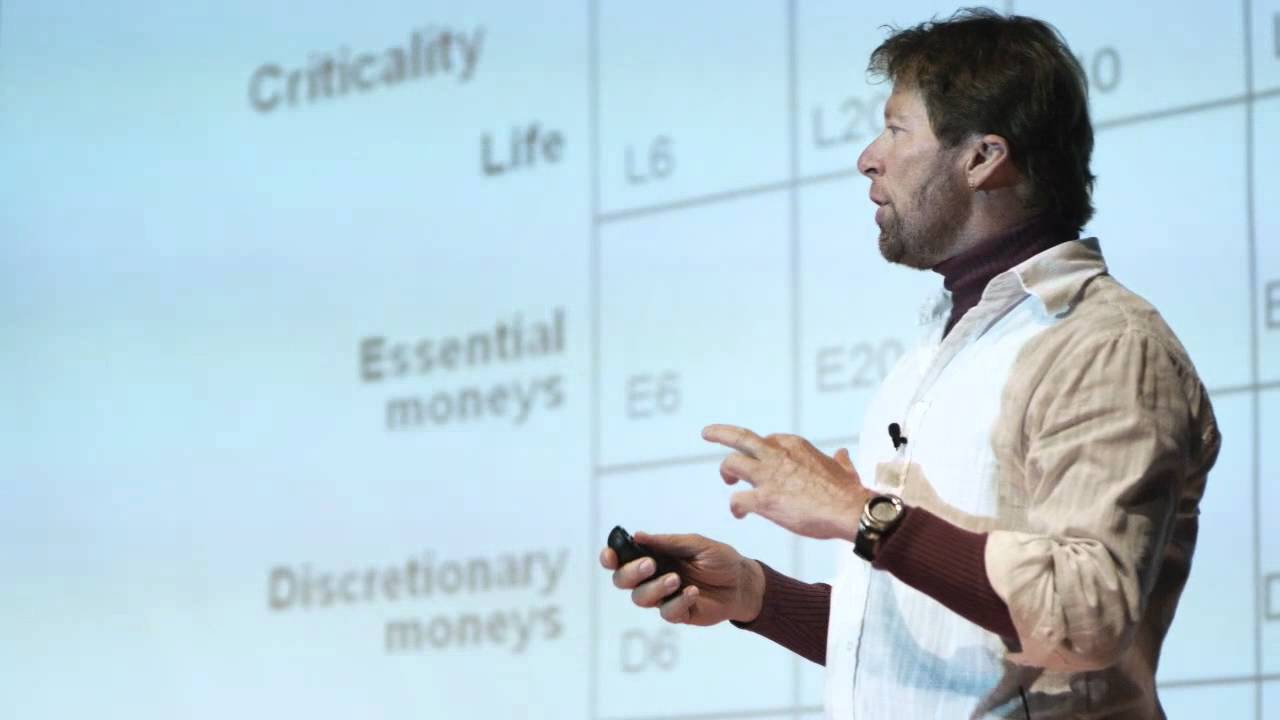
Let's look at a group of people involved in design. We see how they invent, communicate and make decisions. They solve a problem that is not yet fully understood, because this is only the beginning and it is changing. They create a solution, which, of course, they do not understand, because they have just begun, and it changes. They express their ideas through varieties of language, which often do not understand either, and guess what? Those are changing.
')
If you are developing software or engineering solutions, chemical engineering, biochemistry, your final interpreter is merciless. If you are designing something for a human audience, you are very lucky, because it will be indulgent in relation to some things.
Publication support - Edison , which specializes in the development of protective relay systems for power companies and applications for modeling experiments for universities .
Everyone makes some decisions, decisions have economic consequences that affect others, and you have to reduce resources. This is a slide, where there are no analogies and metaphors, where I argue that the problem we are trying to understand is the space we are in and we are looking for a language that will help us understand how to do this work.
A good way is to treat it as a co-game. Therefore, we first need to talk a little about games. This table presents their different types: cooperative games, competitive games, etc. Simple at first. These are competitive games with a specific goal, such as chess or tennis, where the goal is to win the game. You score and know when the game is over.
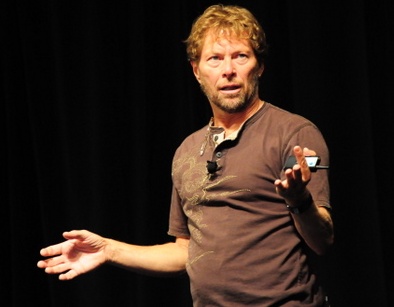
There are games without an account. They end, but the final remains open. Look at the children who play nature in the "king of the hill" - they play until they get tired. They can play until the dinner time comes or until it gets dark and mom calls them. The same with poker, people play before the call like: “Hi, dear, now it is half past one, do you think it’s time to go home?” So, in the end, you still come to an end.
But more interesting is what a guy named James Carse called endless games. Games, the essence of which is in the game. Games that do not imply completion. If the game ends - it's a failure.
And here you use survival. Countries are trying to survive, corporations are trying to survive, bodies are trying to continue to exist and so on. We can explain a lot of interesting things by turning to endless games.
For example, career management. When your child or you leave college yourself, your parents may advise you not to go to work that they pay the most. Go to the job that looks best on your resume and help you get the next one. This is an example of a move in an endless game.
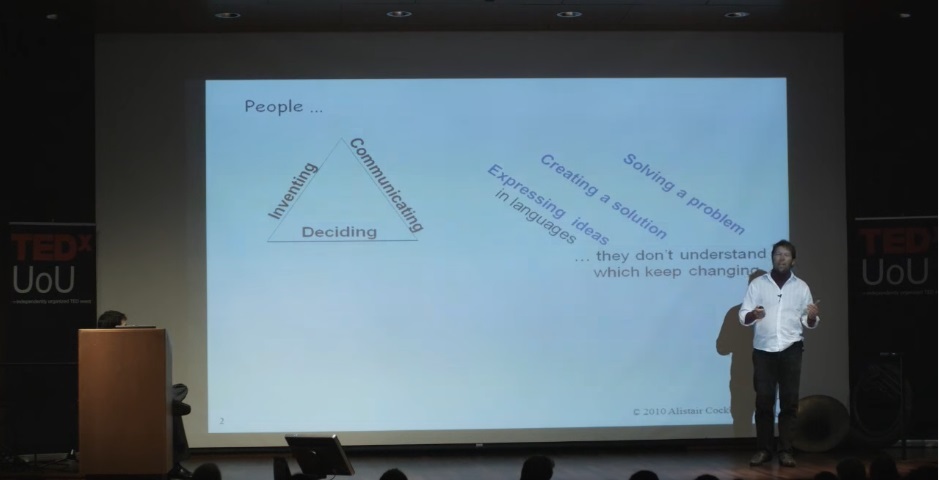
Unfortunately, in the development teams, we see people who play an endless game of career management. We meet in projects people using technologies that don’t give anything to the project, but look good in the resume. I really saw projects that failed due to the fact that the selected technologies were inappropriate.
It turns out that projects are seemingly collaborative games, but they are imbued with these arrows of endless games like survival and career management.
Interestingly, the product line management is also in this category. Imagine a product coming out, let's just call it version 3. Let's pretend that you are unlucky enough to be on the mobile phone market a couple of years ago. Here Apple releases the iPhone, and you make release 3.12, which gives you time to make release 4. This release of release 3.1 is a move in an endless game where you try to buy time to stay in the game.
Returning back, we have a team version of open-ended games like “king of the hill” and poker. There are not many examples here. Jazz music is a great example. The jazz musician doesn't say: “Guys, we only have 10 minutes before I have to leave. Let's speed up. The last time we played was 12 minutes, let's keep it at 10 ”. What happens in jazz? In jazz, they play, and play, and play, until they finish.
At the break, someone told me that there is another example - World of Warcraft. This is an example of people who play a competitive game, but play as a team and do so until they get tired. So there are other approaches to open-ended joint games.
I am interested in the fact that in the lower right corner, where there are many entries in one category. I was surprised to start with mountaineering and software development, when I suddenly discovered that this also applies to publishing magazines, theater, organizing conferences like this, marketing initiatives. All these things that I am talking about also apply to the purchase of technology start-ups, etc. If we can figure out what this group of things is called joint games for a specific purpose (or endless games - a long chain of such things), we will get some language and opportunities to manipulate them. In general, this is part of the game, and it is interesting that when you look at some type of situation, you find yourself in a similar one.
This is important because project or lead managers often think that there is a fixed formula for how to win in these games. I want you to understand that everything is not like chess. You are not embarking on it from the very beginning, just making a plan and winning. The game is constantly changing, the environment is changing, problems are changing, players are changing. There is no fixed formula for victory.
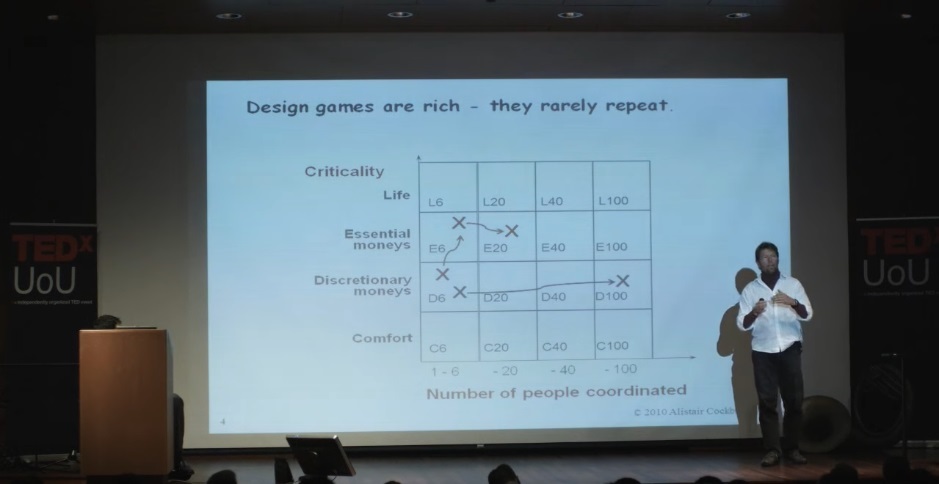
Here we have a very simple table, where I indicated the number of people who need to be coordinated along the horizontal axis, and along the vertical axis criticality, or the harm of life. And there are squares, where the numbers are based on these two parameters. If you have a project in which 6 or less people are involved, then you can put them in one room and let them talk to each other. But when you have 20 people, you can no longer all be in the same room. Perhaps you are already mixing technology. If you have 100 people, you have problems with consistency and interaction.
On the vertical axis we have life losses. For example, at the top are airplanes, nuclear energy, medical equipment, where people die if you have done poorly. Below we are talking about financial losses. Or you can go down, say, to the stage design in a school theater, where the loss will be in comfort. We have different types of checking and controlling violations as we move up.
This table is useful because you can see the trajectories of the projects. In the nineties, I started some projects with two people working on some cool idea, which then received the attention of entire corporations that sent hundreds of people to them. And sooner or later the project stopped, because people continued to think that two people were still working on the project. In their minds it was still a startup. Those of you who represent startups here, through which three hundred people have already passed, should have noticed this.
In the project of the Central Bank of Norway, where they tracked interbank transactions in the country, everyone was concerned with the loss of free money as if it were a three-person project. One day I woke up and said: “This is an interbank transaction in the whole of Norway, tens of millions of crowns pass there”. I set it up a notch. We expanded the project to 20 people, some were in Lillehammer, some in Oslo. I set it higher again. The bottom line was that we did not change the project, we changed our understanding of it.
This is a simplified picture. The real one looks much worse, I showed you a simplified look. About 10-15 years ago, someone cataloged many completely different types of software development projects and they turned out about 35 thousand. That was fifteen years ago. So I wanted to make it very clear that there is no simple fixed formula. If you had a certain strategy and you were so lucky that it worked last time, the chances are very high that this time the same strategy can have unpleasant consequences.
The next question is team games. Cooperative games bring to the fore human problems. In particular, issues of trust and personal security. When something goes wrong (and, by the way, something always goes wrong), it is embarrassing to say that your joke - it sucks, that your bridges will collapse, that your chemical reaction will not work. And you need to know about it as soon as possible. The question is whether people will talk about this to each other and whether they will listen to each other. Is the team reliable enough to give bad news? Is it benevolent enough to accept bad news?

I experienced it yesterday. I rehearsed my speech yesterday and at the end one of my friends sat down and said: “Do you want to hear a review?” I thought, “No, shut up, I made it for 25 minutes, I can speak faster and meet at 20 tomorrow.” But I said, "Yes, of course." And after a very polite and thoughtful review, we wrote this whole speech for last night. Think: here is my friend, what kind of personal security does he need to say: “Hey, Alistair, I know it will be at TED tomorrow. It sucks. You know, try again. ” It is very hard. And he is now in the hall. But it was very good. This is an example of how to transmit bad news quickly.

The last thing I’ll say is communication. There is a quick test. In using the concept of playing together, you need to be able to look at office equipment and where ideas go quickly and where it goes slowly. Here we see the glorious ThoughtWorks office in Chicago. He is very modern. When I look at it, I see coatings that absorb sound, I see high ceilings that scatter sound and expand the space. They have arcuate tables that are actually pretty lousy because you can't bring a colleague and move the screen forward. But what I also noticed, and I hope that you noticed, these are two people working side by side, they have very intensive communication, they exchange ideas incredibly quickly.
I talked about this with a very famous person, Tom DeMarco, and he said: “Communication is not a perfume. It does not get stronger when you get closer. ” I thought about it and said: “Yes, she is exactly like a perfume! The closer you are, the better you notice eye movements, you can see what they are thinking. ”
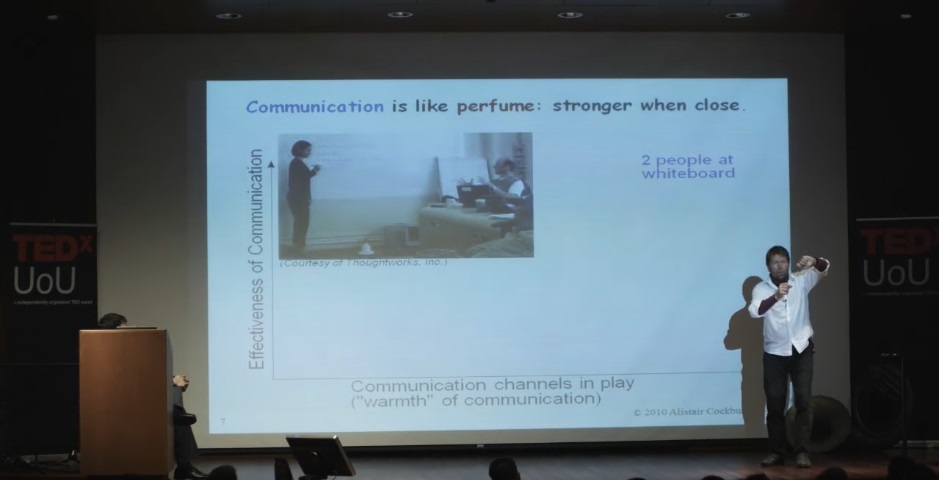
If we look at two people talking at the blackboard, what will we see? Answers to questions in real time. You can see all the details of the person, their proximity: they move on (I do not agree with you) or come closer (I want to interrupt you). You have gestures. You see how people speak at the board while they are drawing, and you get a connection between the sound and the visual component. All this in the present tense.
Or phone: you still have voice intonations and answers to questions in real time, but you miss gestures and facial expressions. You enter the chat and lose everything, except for the answers in real time. You see how this curve goes down. This is all when answering questions in real time.
What do you do if you are in different time zones or are engaged in archival documentation? You copy the same curve, and you can make a video recording, as one person explains the design to another person. 3-5-minute videos that people are now doing on mobile phones, digital cameras, spread on the network and people in other time zones receive them. You can use this with clients when the vice president of marketing says: “That's what I need.” Record on video, do not shift to paper. And what do we constantly use? Paper! The thing that is least effective of all. Let it be electronic, nevertheless it is paper.
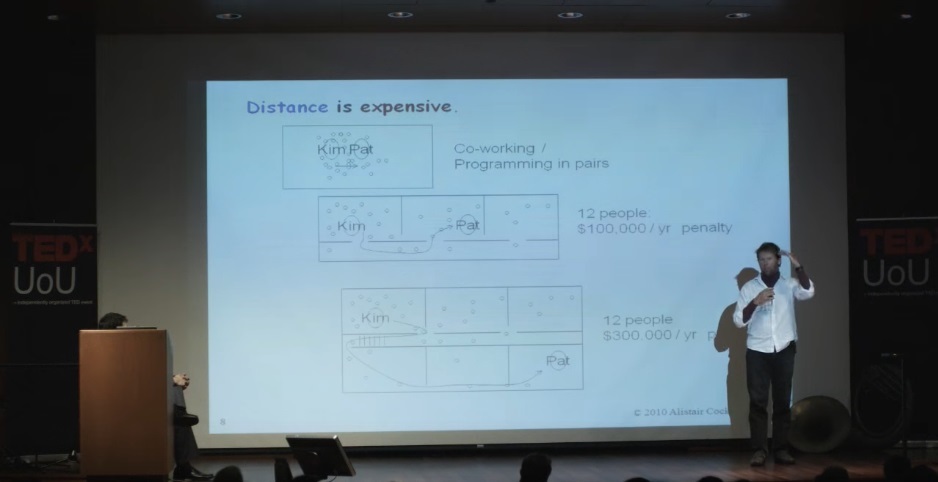
The last topic I’ll touch on is the cost of distances. I know that virtual teams are everywhere, but in our last speech we heard someone call it a shame that we outsource all these biotechnological projects, because we don’t have the opportunity to build a team on site. So distances are expensive. The study shows that people will not go more than the length of the school bus to ask a question. The communication curve sharply goes down at a mark of 10 meters.
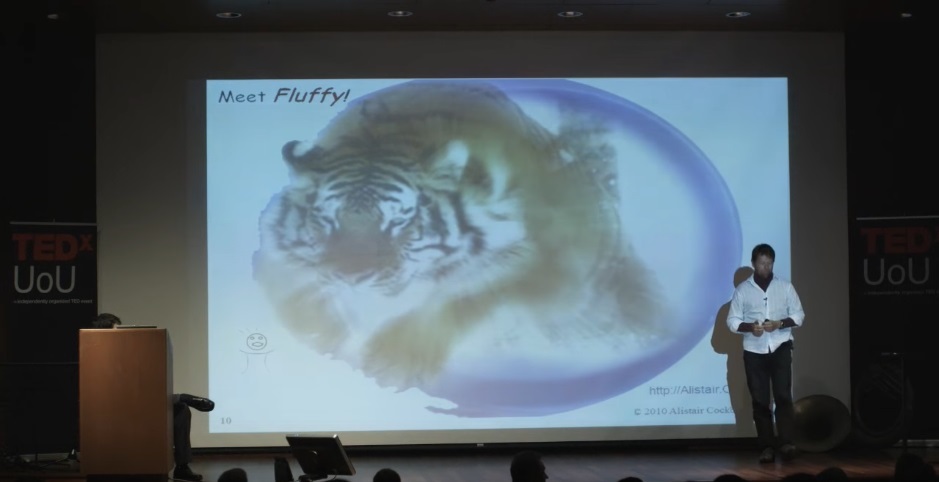
So, we discussed games, strategies, promotions, different types of communication, talked about trust. People have already heard about this in business, especially not engineering. And this is normal, if you are in the theater, people in the theater can be people. But engineers must be something else, I don’t know what. I am sometimes told that these collaborative games, people, distrust are such fluffy topics. Therefore, in the end I want to introduce you to my friend Fluffy. This is my talisman. And that surprised man over there in the corner is a techie who has just been promoted to team leader and he first met Fuzzy.
Translation: Katya Shershneva

Let's look at a group of people involved in design. We see how they invent, communicate and make decisions. They solve a problem that is not yet fully understood, because this is only the beginning and it is changing. They create a solution, which, of course, they do not understand, because they have just begun, and it changes. They express their ideas through varieties of language, which often do not understand either, and guess what? Those are changing.
')
If you are developing software or engineering solutions, chemical engineering, biochemistry, your final interpreter is merciless. If you are designing something for a human audience, you are very lucky, because it will be indulgent in relation to some things.
Publication support - Edison , which specializes in the development of protective relay systems for power companies and applications for modeling experiments for universities .
Everyone makes some decisions, decisions have economic consequences that affect others, and you have to reduce resources. This is a slide, where there are no analogies and metaphors, where I argue that the problem we are trying to understand is the space we are in and we are looking for a language that will help us understand how to do this work.
A good way is to treat it as a co-game. Therefore, we first need to talk a little about games. This table presents their different types: cooperative games, competitive games, etc. Simple at first. These are competitive games with a specific goal, such as chess or tennis, where the goal is to win the game. You score and know when the game is over.

There are games without an account. They end, but the final remains open. Look at the children who play nature in the "king of the hill" - they play until they get tired. They can play until the dinner time comes or until it gets dark and mom calls them. The same with poker, people play before the call like: “Hi, dear, now it is half past one, do you think it’s time to go home?” So, in the end, you still come to an end.
But more interesting is what a guy named James Carse called endless games. Games, the essence of which is in the game. Games that do not imply completion. If the game ends - it's a failure.
And here you use survival. Countries are trying to survive, corporations are trying to survive, bodies are trying to continue to exist and so on. We can explain a lot of interesting things by turning to endless games.
For example, career management. When your child or you leave college yourself, your parents may advise you not to go to work that they pay the most. Go to the job that looks best on your resume and help you get the next one. This is an example of a move in an endless game.

Unfortunately, in the development teams, we see people who play an endless game of career management. We meet in projects people using technologies that don’t give anything to the project, but look good in the resume. I really saw projects that failed due to the fact that the selected technologies were inappropriate.
It turns out that projects are seemingly collaborative games, but they are imbued with these arrows of endless games like survival and career management.
Interestingly, the product line management is also in this category. Imagine a product coming out, let's just call it version 3. Let's pretend that you are unlucky enough to be on the mobile phone market a couple of years ago. Here Apple releases the iPhone, and you make release 3.12, which gives you time to make release 4. This release of release 3.1 is a move in an endless game where you try to buy time to stay in the game.
Returning back, we have a team version of open-ended games like “king of the hill” and poker. There are not many examples here. Jazz music is a great example. The jazz musician doesn't say: “Guys, we only have 10 minutes before I have to leave. Let's speed up. The last time we played was 12 minutes, let's keep it at 10 ”. What happens in jazz? In jazz, they play, and play, and play, until they finish.
At the break, someone told me that there is another example - World of Warcraft. This is an example of people who play a competitive game, but play as a team and do so until they get tired. So there are other approaches to open-ended joint games.
I am interested in the fact that in the lower right corner, where there are many entries in one category. I was surprised to start with mountaineering and software development, when I suddenly discovered that this also applies to publishing magazines, theater, organizing conferences like this, marketing initiatives. All these things that I am talking about also apply to the purchase of technology start-ups, etc. If we can figure out what this group of things is called joint games for a specific purpose (or endless games - a long chain of such things), we will get some language and opportunities to manipulate them. In general, this is part of the game, and it is interesting that when you look at some type of situation, you find yourself in a similar one.
This is important because project or lead managers often think that there is a fixed formula for how to win in these games. I want you to understand that everything is not like chess. You are not embarking on it from the very beginning, just making a plan and winning. The game is constantly changing, the environment is changing, problems are changing, players are changing. There is no fixed formula for victory.

Here we have a very simple table, where I indicated the number of people who need to be coordinated along the horizontal axis, and along the vertical axis criticality, or the harm of life. And there are squares, where the numbers are based on these two parameters. If you have a project in which 6 or less people are involved, then you can put them in one room and let them talk to each other. But when you have 20 people, you can no longer all be in the same room. Perhaps you are already mixing technology. If you have 100 people, you have problems with consistency and interaction.
On the vertical axis we have life losses. For example, at the top are airplanes, nuclear energy, medical equipment, where people die if you have done poorly. Below we are talking about financial losses. Or you can go down, say, to the stage design in a school theater, where the loss will be in comfort. We have different types of checking and controlling violations as we move up.
This table is useful because you can see the trajectories of the projects. In the nineties, I started some projects with two people working on some cool idea, which then received the attention of entire corporations that sent hundreds of people to them. And sooner or later the project stopped, because people continued to think that two people were still working on the project. In their minds it was still a startup. Those of you who represent startups here, through which three hundred people have already passed, should have noticed this.
In the project of the Central Bank of Norway, where they tracked interbank transactions in the country, everyone was concerned with the loss of free money as if it were a three-person project. One day I woke up and said: “This is an interbank transaction in the whole of Norway, tens of millions of crowns pass there”. I set it up a notch. We expanded the project to 20 people, some were in Lillehammer, some in Oslo. I set it higher again. The bottom line was that we did not change the project, we changed our understanding of it.
This is a simplified picture. The real one looks much worse, I showed you a simplified look. About 10-15 years ago, someone cataloged many completely different types of software development projects and they turned out about 35 thousand. That was fifteen years ago. So I wanted to make it very clear that there is no simple fixed formula. If you had a certain strategy and you were so lucky that it worked last time, the chances are very high that this time the same strategy can have unpleasant consequences.
The next question is team games. Cooperative games bring to the fore human problems. In particular, issues of trust and personal security. When something goes wrong (and, by the way, something always goes wrong), it is embarrassing to say that your joke - it sucks, that your bridges will collapse, that your chemical reaction will not work. And you need to know about it as soon as possible. The question is whether people will talk about this to each other and whether they will listen to each other. Is the team reliable enough to give bad news? Is it benevolent enough to accept bad news?

I experienced it yesterday. I rehearsed my speech yesterday and at the end one of my friends sat down and said: “Do you want to hear a review?” I thought, “No, shut up, I made it for 25 minutes, I can speak faster and meet at 20 tomorrow.” But I said, "Yes, of course." And after a very polite and thoughtful review, we wrote this whole speech for last night. Think: here is my friend, what kind of personal security does he need to say: “Hey, Alistair, I know it will be at TED tomorrow. It sucks. You know, try again. ” It is very hard. And he is now in the hall. But it was very good. This is an example of how to transmit bad news quickly.

The last thing I’ll say is communication. There is a quick test. In using the concept of playing together, you need to be able to look at office equipment and where ideas go quickly and where it goes slowly. Here we see the glorious ThoughtWorks office in Chicago. He is very modern. When I look at it, I see coatings that absorb sound, I see high ceilings that scatter sound and expand the space. They have arcuate tables that are actually pretty lousy because you can't bring a colleague and move the screen forward. But what I also noticed, and I hope that you noticed, these are two people working side by side, they have very intensive communication, they exchange ideas incredibly quickly.
I talked about this with a very famous person, Tom DeMarco, and he said: “Communication is not a perfume. It does not get stronger when you get closer. ” I thought about it and said: “Yes, she is exactly like a perfume! The closer you are, the better you notice eye movements, you can see what they are thinking. ”

If we look at two people talking at the blackboard, what will we see? Answers to questions in real time. You can see all the details of the person, their proximity: they move on (I do not agree with you) or come closer (I want to interrupt you). You have gestures. You see how people speak at the board while they are drawing, and you get a connection between the sound and the visual component. All this in the present tense.
Or phone: you still have voice intonations and answers to questions in real time, but you miss gestures and facial expressions. You enter the chat and lose everything, except for the answers in real time. You see how this curve goes down. This is all when answering questions in real time.
What do you do if you are in different time zones or are engaged in archival documentation? You copy the same curve, and you can make a video recording, as one person explains the design to another person. 3-5-minute videos that people are now doing on mobile phones, digital cameras, spread on the network and people in other time zones receive them. You can use this with clients when the vice president of marketing says: “That's what I need.” Record on video, do not shift to paper. And what do we constantly use? Paper! The thing that is least effective of all. Let it be electronic, nevertheless it is paper.

The last topic I’ll touch on is the cost of distances. I know that virtual teams are everywhere, but in our last speech we heard someone call it a shame that we outsource all these biotechnological projects, because we don’t have the opportunity to build a team on site. So distances are expensive. The study shows that people will not go more than the length of the school bus to ask a question. The communication curve sharply goes down at a mark of 10 meters.

So, we discussed games, strategies, promotions, different types of communication, talked about trust. People have already heard about this in business, especially not engineering. And this is normal, if you are in the theater, people in the theater can be people. But engineers must be something else, I don’t know what. I am sometimes told that these collaborative games, people, distrust are such fluffy topics. Therefore, in the end I want to introduce you to my friend Fluffy. This is my talisman. And that surprised man over there in the corner is a techie who has just been promoted to team leader and he first met Fuzzy.
Translation: Katya Shershneva
Source: https://habr.com/ru/post/315642/
All Articles